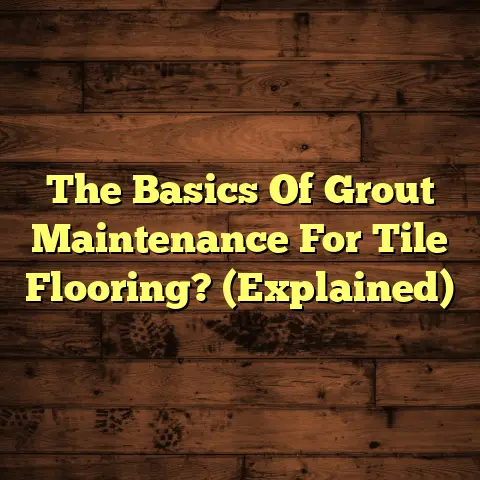Remove Glue From Wood? (No Sanding!)
Imagine this: You’ve just completed a beautiful woodworking project, pouring your heart and soul into every cut and joint.
The wood gleams under the soft light, showcasing the natural grain and color that you painstakingly chose.
But then, disaster strikes.
A misplaced drop of glue has dried on the surface, marring your masterpiece.
Your stomach sinks as you realize that this simple mistake could ruin all your hard work.
Been there, felt that!
But what if I told you that there’s hope?
You don’t have to reach for the sander or resort to damaging that beautiful finish you’ve created.
This article will guide you through effective, no-sanding methods to remove glue from wood, restoring your project to its original glory without sacrificing its beauty.
Let’s dive in, shall we?
1. Understanding the Glue Types
Alright, before we get our hands dirty, let’s talk glue.
Not all glues are created equal, and knowing what you’re dealing with is half the battle.
Think of it like this: you wouldn’t use the same tool to remove a tiny tack as you would to demolish a wall, right?
Same principle applies here.
Here’s a quick rundown of the most common types you’ll encounter in woodworking:
-
PVA Glue (Polyvinyl Acetate): This is your everyday wood glue, the stuff you probably have sitting in your workshop right now. It’s water- based, dries clear, and is great for general woodworking projects. Think Elmer’s Wood Glue.
-
Epoxy: This is the heavy-duty stuff. Epoxy is a two-part adhesive that creates a super strong, water-resistant bond. It’s often used for projects that require a lot of strength or will be exposed to moisture.
-
Polyurethane Glue: Another strong contender, polyurethane glue is known for its ability to bond a variety of materials, including wood, metal, and plastic. It’s also water-resistant and expands as it dries, filling gaps and creating a tight seal.
-
Cyanoacrylate Glue (Super Glue): This is the instant bond king. Super glue dries incredibly fast and creates a strong, brittle bond. It’s great for small repairs and quick fixes, but not ideal for large woodworking projects.
Why Does It Matter?
Identifying the type of glue is crucial because different glues respond differently to various removal methods.
For example, water-based glues like PVA are more susceptible to heat and moisture, while epoxy and polyurethane glues might require stronger solvents.
Ignoring this step could lead to ineffective removal attempts or, worse, damage to your wood.
I once spent a frustrating afternoon trying to remove epoxy with a method that worked perfectly on PVA.
Let me tell you, it was not a fun experience.
Take the time to identify your glue – it’ll save you time, effort, and a whole lot of headaches.
2. The Impact of Glue on Wood Surfaces
Okay, so you’ve got glue on your wood.
It’s not just about the unsightly blob; it’s about what that glue is doing to your beautiful finish.
Think of your wood finish as a protective shield, guarding the wood from moisture, scratches, and other damage.
When glue lands on that finish, it can disrupt this shield in several ways:
-
Altered Sheen: Glue can leave a dull or glossy spot on the finish, depending on the type of glue and the finish itself. This creates an uneven appearance that can be quite noticeable.
-
Staining: Some glues can actually stain the wood or the finish, especially if left to sit for an extended period. This is more common with glues that contain dyes or pigments.
-
Adhesion Issues: The glue itself becomes an additional layer on the surface, and any attempt to apply a new coat of finish over the glue will likely result in poor adhesion and an uneven look.
I remember one time I was working on a cherry wood table.
I had just applied a beautiful oil-based finish, and of course, a drop of polyurethane glue decided to make its grand entrance right in the middle of the tabletop.
The frustration was real!
It felt like all my hard work was about to be ruined.
It’s important to remember that your reaction matters.
Take a deep breath, assess the situation, and remember that there are ways to fix this without resorting to drastic measures like sanding.
3. Safety First: Preparing for Glue Removal
Alright, before we start melting, dissolving, or scraping, let’s talk safety.
Glue removal can involve some potentially hazardous materials and techniques, so it’s crucial to take the necessary precautions to protect yourself.
Here’s what you need to keep in mind:
-
Ventilation: Always work in a well-ventilated area. Some solvents can release harmful fumes, so make sure you have plenty of fresh air circulating. Open windows and doors, or use a fan to create airflow.
-
Gloves: Protect your hands from harsh chemicals and potential skin irritation by wearing gloves. Nitrile gloves are a good choice, as they are resistant to most solvents.
-
Eye Protection: Safety goggles or glasses are a must, especially when working with solvents or using tools that could send debris flying. You don’t want to risk getting glue or chemicals in your eyes.
-
Read the Labels: If you’re using commercial glue removers or solvents, carefully read the product labels and follow the manufacturer’s instructions. Pay attention to any warnings or precautions.
Tools and Materials Checklist
Okay, now that we’ve covered safety, let’s gather our tools and materials.
Here’s a list of what you’ll likely need:
- Heat Gun or Hairdryer: For softening glue.
- Solvents: White vinegar, rubbing alcohol (isopropyl alcohol), acetone (for certain glues, use with caution), or commercial glue removers.
- Clean Cloths or Rags: For applying solvents and wiping away dissolved glue.
- Plastic Scraper or Putty Knife: For gently scraping away softened glue. Avoid metal scrapers, as they can scratch the wood.
- Cotton Swabs: For applying solvents to small or hard-to-reach areas.
- Water: For water-based techniques.
- Spray Bottle: For applying water or solvents in a controlled manner.
- Soft Brush: For scrubbing gently.
- Mineral Oil or Furniture Polish: For restoring the finish after glue removal (if necessary).
4. Step-by-Step Guide to Removing Glue Without Sanding
Alright, now for the fun part!
Let’s get that glue off your wood without resorting to sandpaper.
Here are four methods you can try, depending on the type of glue and the finish on your wood:
Method 1: Using Heat
Heat can be your best friend when it comes to softening certain types of glue, especially PVA and other water-based adhesives.
The heat helps to break down the bond between the glue and the wood, making it easier to remove.
How It Works:
Heat softens the glue, making it pliable and easier to scrape away without damaging the wood’s surface or finish.
Step-by-Step Instructions:
-
Prepare the Area: Clean the area around the glue with a damp cloth to remove any loose debris or dirt.
-
Apply Heat: Using a heat gun or hairdryer on a low setting, direct the heat onto the glue stain. Move the heat source in a circular motion to avoid overheating one spot.
-
Test the Glue: After a few seconds, test the glue with a plastic scraper to see if it has softened. If not, continue applying heat for a few more seconds.
-
Scrape the Glue: Gently scrape the softened glue away with a plastic scraper. Work in the direction of the wood grain to avoid scratching the surface.
-
Repeat if Necessary: If the glue is stubborn, repeat the heating and scraping process until all the glue is removed.
-
Clean the Surface: Once the glue is removed, clean the area with a damp cloth and dry it thoroughly.
Important Considerations:
-
Heat Gun vs. Hairdryer: A heat gun provides more intense heat than a hairdryer, so use it with caution. Start with the lowest setting and increase the heat gradually as needed.
-
Avoid Overheating: Overheating the wood can damage the finish or even scorch the wood itself. Keep the heat source moving and avoid focusing on one spot for too long.
Method 2: Chemical Solvents
Chemical solvents can be effective for removing tougher glues like epoxy or polyurethane.
However, it’s crucial to choose the right solvent and use it safely to avoid damaging the wood or finish.
How It Works:
Solvents dissolve the glue, breaking down its chemical structure and making it easier to wipe or scrape away.
Step-by-Step Instructions:
-
Choose Your Solvent: Select a solvent that is appropriate for the type of glue you’re dealing with. White vinegar or rubbing alcohol are good options for PVA glue, while acetone or commercial glue removers may be necessary for epoxy or polyurethane.
-
Test in an Inconspicuous Area: Before applying the solvent to the glue stain, test it in an inconspicuous area of the wood to make sure it doesn’t damage the finish.
-
Apply the Solvent: Soak a clean cloth or cotton swab with the solvent and gently apply it to the glue stain. Allow the solvent to sit on the glue for a few minutes to soften it.
-
Wipe or Scrape: After a few minutes, try wiping away the softened glue with a clean cloth. If the glue is stubborn, use a plastic scraper to gently scrape it away.
-
Repeat if Necessary: Repeat the application and removal process until all the glue is gone.
-
Clean the Surface: Once the glue is removed, clean the area with a damp cloth and dry it thoroughly.
Important Considerations:
-
Ventilation: As mentioned earlier, always work in a well-ventilated area when using solvents.
-
Safety Precautions: Wear gloves and eye protection to protect yourself from chemical exposure.
-
Solvent Compatibility: Be sure to choose a solvent that is compatible with the type of finish on your wood. Some solvents can damage or dissolve certain finishes.
Method 3: Water-Based Techniques
For water-based glues like PVA, sometimes the simplest solution is the best: water.
Moisture can help to soften the glue and make it easier to remove without damaging the wood.
How It Works:
Water penetrates the glue, weakening its bond with the wood and making it easier to wipe or scrape away.
Step-by-Step Instructions:
-
Dampen a Cloth or Sponge: Wet a clean cloth or sponge with warm water.
-
Apply to the Glue: Gently dab the damp cloth or sponge onto the glue stain, making sure to saturate the glue thoroughly.
-
Let It Sit: Allow the water to sit on the glue for several minutes to soften it.
-
Wipe or Scrape: After a few minutes, try wiping away the softened glue with the cloth or sponge. If the glue is stubborn, use a plastic scraper to gently scrape it away.
-
Repeat if Necessary: Repeat the application and removal process until all the glue is gone.
-
Dry the Surface: Once the glue is removed, dry the area thoroughly with a clean cloth.
Important Considerations:
-
Avoid Over-Wetting: Be careful not to over-wet the wood, as this can cause it to warp or swell. Use just enough water to saturate the glue without soaking the surrounding wood.
-
Gentle Scrubbing: If the glue is particularly stubborn, you can try gently scrubbing the area with a soft brush or toothbrush while applying water.
Method 4: Scraping Techniques
Sometimes, a little elbow grease is all you need to remove glue from wood.
Scraping can be an effective method for removing dried glue, but it’s important to use the right tools and techniques to avoid damaging the wood.
How It Works:
Careful scraping removes the glue layer by layer, without digging into the wood’s surface or finish.
Step-by-Step Instructions:
-
Choose Your Tool: Select a plastic scraper or putty knife with a sharp edge. Avoid metal scrapers, as they can easily scratch the wood.
-
Soften the Glue (Optional): If the glue is particularly hard or brittle, you can try softening it with heat or a solvent before scraping.
-
Scrape Gently: Hold the scraper at a low angle and gently scrape the glue away from the wood. Work in the direction of the wood grain to avoid scratching the surface.
-
Apply Even Pressure: Use even pressure and avoid pressing too hard, as this can damage the wood.
-
Repeat if Necessary: Repeat the scraping process until all the glue is removed.
-
Clean the Surface: Once the glue is removed, clean the area with a damp cloth and dry it thoroughly.
Important Considerations:
-
Sharp Edge: Make sure your scraper has a sharp edge to avoid tearing or gouging the wood.
-
Low Angle: Holding the scraper at a low angle will help to distribute the pressure and prevent scratching.
-
Patience is Key: Scraping can be a slow and tedious process, so be patient and take your time.
5. Post-Removal Care
You’ve successfully removed the glue. High five!
But our job’s not quite done.
Now, we need to make sure the wood looks its best and that the finish is properly restored.
Here’s what you need to do:
-
Cleaning the Surface: After removing the glue, clean the area with a damp cloth to remove any residual solvent or debris. Dry the surface thoroughly with a clean cloth.
-
Assessing the Finish: Inspect the finish to see if it has been damaged by the glue removal process. Look for dull spots, scratches, or discoloration.
-
Restoring the Finish: If the finish has been damaged, you may need to touch it up with a compatible finish. Use a small brush or cloth to apply the finish to the affected area, following the manufacturer’s instructions.
-
Polishing the Wood: Once the finish has dried, you can polish the wood with mineral oil or furniture polish to restore its shine and protect it from future damage.
6. Preventing Future Glue Mishaps
Okay, let’s be honest: prevention is always better than cure.
Here are some tips for avoiding glue spills and mishaps in the first place:
-
Use a Glue Bottle with a Fine Tip: A glue bottle with a fine tip will give you more control over the amount of glue you apply, reducing the risk of spills.
-
Apply Glue Sparingly: Less is often more when it comes to glue. Apply just enough glue to create a strong bond, and avoid over-applying it.
-
Use Clamps: Clamps can help to hold your wood pieces together while the glue dries, preventing them from shifting and causing glue to squeeze out.
-
Protect Your Work Surface: Cover your work surface with a drop cloth or wax paper to protect it from glue spills.
-
Clean Up Spills Immediately: If you do spill glue, clean it up immediately with a damp cloth. The longer you wait, the harder it will be to remove.
7. Conclusion
So, there you have it: several effective, no-sanding methods for removing glue from wood.
Whether you choose to use heat, solvents, water, or scraping, the key is to be patient, gentle, and to take the necessary precautions to protect yourself and your wood.
Remember, woodworking is a journey of creativity and resilience.
Mistakes happen, but they don’t have to ruin your project.
With a little knowledge and the right techniques, you can overcome any challenge and create beautiful, flawless pieces that you can be proud of.
Now go forth and create!





